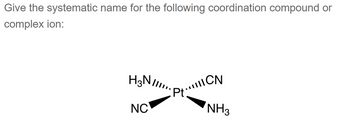
Chemistry
10th Edition
ISBN: 9781305957404
Author: Steven S. Zumdahl, Susan A. Zumdahl, Donald J. DeCoste
Publisher: Cengage Learning
expand_more
expand_more
format_list_bulleted
Question

Transcribed Image Text:Give the systematic name for the following coordination compound or
complex ion:
H3 NIIII..
NC
Pt...CN
NH3
Expert Solution
This question has been solved!
Explore an expertly crafted, step-by-step solution for a thorough understanding of key concepts.
Step by stepSolved in 2 steps

Knowledge Booster
Similar questions
- (a) Name this coordination compound: [Ag(NH3)2]NO3. (b) Write the formula of pentaaquaisothiocyanatoiron(III) chloride.arrow_forwardVitamin B12 is a coordination compound with cobalt as its central atom. It contains 4.4% cobalt by mass and has a molar mass of 1.3103 g/mol. How many cobalt atoms are in a molecule of vitamin B12?arrow_forwardFour different octahedral chromium coordination compounds exist that all have the same oxidation state for chromium and have H2O and Cl as the ligands and counterions. When 1 mole of each of the four compounds is dissolved in water, how many moles of silver chloride will precipitate upon addition of excess AgNO3?arrow_forward
- The square-planar complex Pt(en)Cl2 has chloride ligands in a cis configuration. No trans isomer is known. Based on the bond lengths and bond angles of carbon and nitrogen in the ethylenediamine ligand, explain why the trans compound is not possible.arrow_forwarda. In the absorption spectrum of the complex ion Cr(NCS)63, there is a band corresponding to the absorption of a photon of light with an energy of 1.75 104 cm-1. Given 1 cm1 = 1.986 1023 J, what is the wavelength of this photon? b. The CrNC bond angle in Cr(NCS)63 is predicted to be 180. What is the hybridization of the N atom in the Ncs- ligand when a Lewis acid-base reaction occurs between Cr3+ and NCs- that would give a 180 CrNC bond angle? Cr(NCS)63 undergoes substitution by ethylenediamine (en) according to the equation Cr(NCS)63+2enCr(NCS)2(en)2++4NCS Does Cr(NCS)2(en)2+ exhibit geometric isomerism? Does Cr(NCS)2(en)2+ exhibit optical isomerism?arrow_forwardA certain coordination compound has the simplest formula PtN2H6Cl2. It has a molar mass of about 600 g/mol and contains both a complex cation and a complex anion. What is its structure?arrow_forward
- How many geometric isomers of the complex ion [Cr(dmen)3]3+ can exist? (dmen is the bidentate ligand 1,1-dimethylethylenediamine.) 1,1-Dimethylethylenediamine, dmenarrow_forwardTrimethylphosphine, P(CH3)3, can act as a ligand by donating the lone pair of electrons on the phosphorus atom. If trimethylphosphine is added to a solution of nickel(Il) chloride in acetone, a blue compound that has a molecular mass of approximately 270 g and contains 21.5% Ni, 26.0% Cl, and 52.5% P(CH3)3 can be isolated. This blue compound does not have any isomeric forms. What are the geometry and molecular formula of the blue compound?arrow_forwardThe glycinate ion, H2NCH2CO2, formed by deprotonation of the amino acid glycine, can function as a bidentate ligand, coordinating to a metal through the nitrogen of the amino group and one of the oxygen atoms. Glycinate ion, a bidentate ligand A copper complex of this ligand has the formula Cu(H2NCH2CO2)2(H2O)2. For this complex, determine the following: (a) the oxidation state of copper (b) the coordination number of copper (c) the number of unpaired electrons (d) whether the complex is diamagnetic or paramagneticarrow_forward
- Give the coordination number for each metal ion in the following compounds: (a) [Co(CO3)3]3- (note that CO32- is bidentate in this complex). (b) [Cu(NH3)4]2+. (c) [Co(NH3)4Br2]2(SO4)3. (d) [Pt(NH3)4][PtCl4]. (e) [Cr(en)3](NO3)3. (f) [Pd(NH3)2Br2] (square planar). (g) K3[Cu(Cl)5]. (h) [Zn(NH3)2Cl2]arrow_forwardThe complex ion PdCl42is diamagnetic. Propose a structure for PdCl42.arrow_forwardHow many geometric isomers are possible for the square-planar complex ion [Pt(NH3)(CN)Cl2)?arrow_forward
arrow_back_ios
SEE MORE QUESTIONS
arrow_forward_ios
Recommended textbooks for you
 ChemistryChemistryISBN:9781305957404Author:Steven S. Zumdahl, Susan A. Zumdahl, Donald J. DeCostePublisher:Cengage Learning
ChemistryChemistryISBN:9781305957404Author:Steven S. Zumdahl, Susan A. Zumdahl, Donald J. DeCostePublisher:Cengage Learning Chemistry: An Atoms First ApproachChemistryISBN:9781305079243Author:Steven S. Zumdahl, Susan A. ZumdahlPublisher:Cengage Learning
Chemistry: An Atoms First ApproachChemistryISBN:9781305079243Author:Steven S. Zumdahl, Susan A. ZumdahlPublisher:Cengage Learning
 Chemistry: The Molecular ScienceChemistryISBN:9781285199047Author:John W. Moore, Conrad L. StanitskiPublisher:Cengage Learning
Chemistry: The Molecular ScienceChemistryISBN:9781285199047Author:John W. Moore, Conrad L. StanitskiPublisher:Cengage Learning Chemistry: Principles and ReactionsChemistryISBN:9781305079373Author:William L. Masterton, Cecile N. HurleyPublisher:Cengage Learning
Chemistry: Principles and ReactionsChemistryISBN:9781305079373Author:William L. Masterton, Cecile N. HurleyPublisher:Cengage Learning Chemistry & Chemical ReactivityChemistryISBN:9781337399074Author:John C. Kotz, Paul M. Treichel, John Townsend, David TreichelPublisher:Cengage Learning
Chemistry & Chemical ReactivityChemistryISBN:9781337399074Author:John C. Kotz, Paul M. Treichel, John Townsend, David TreichelPublisher:Cengage Learning

Chemistry
Chemistry
ISBN:9781305957404
Author:Steven S. Zumdahl, Susan A. Zumdahl, Donald J. DeCoste
Publisher:Cengage Learning

Chemistry: An Atoms First Approach
Chemistry
ISBN:9781305079243
Author:Steven S. Zumdahl, Susan A. Zumdahl
Publisher:Cengage Learning


Chemistry: The Molecular Science
Chemistry
ISBN:9781285199047
Author:John W. Moore, Conrad L. Stanitski
Publisher:Cengage Learning

Chemistry: Principles and Reactions
Chemistry
ISBN:9781305079373
Author:William L. Masterton, Cecile N. Hurley
Publisher:Cengage Learning

Chemistry & Chemical Reactivity
Chemistry
ISBN:9781337399074
Author:John C. Kotz, Paul M. Treichel, John Townsend, David Treichel
Publisher:Cengage Learning